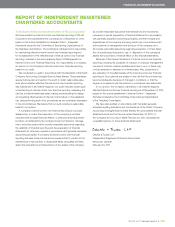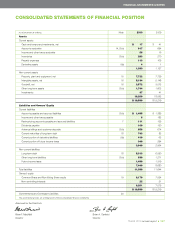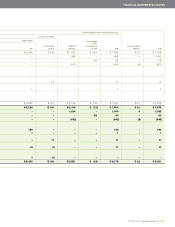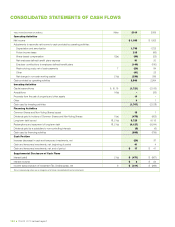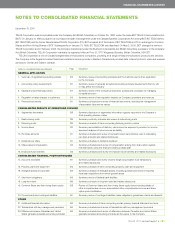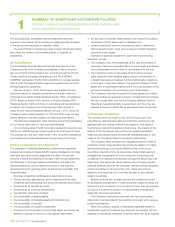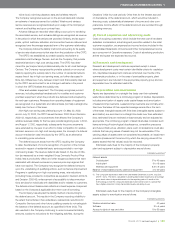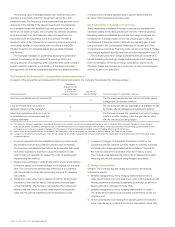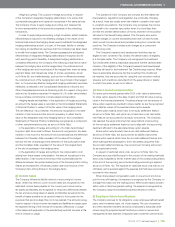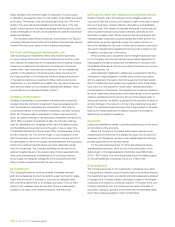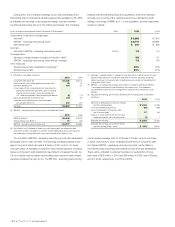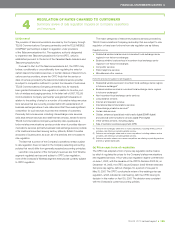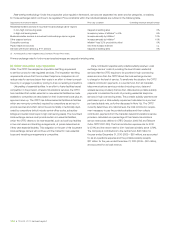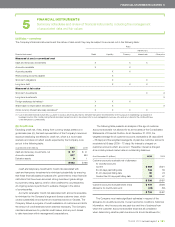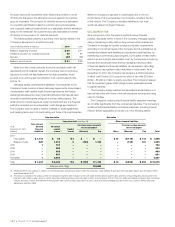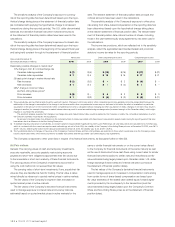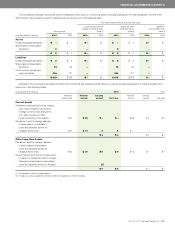Telus 2010 Annual Report Download - page 129
Download and view the complete annual report
Please find page 129 of the 2010 Telus annual report below. You can navigate through the pages in the report by either clicking on the pages listed below, or by using the keyword search tool below to find specific information within the annual report.
TELUS 2010 annual report . 125
FINANCIAL STATEMENTS & NOTES: 1
The operations of the Company are complex and the related tax
interpretations, regulations and legislation are continually changing.
As a result, there are usually some tax matters in question that result
in uncertain tax positions. The Company only recognizes the income
tax benefit of an uncertain tax position when it is more likely than
not that the ultimate determination of the tax treatment of the position
will result in that benefit being realized. The Company accrues for
interest charges on current tax liabilities that have not been funded,
which would include interest and penalties arising from uncertain tax
positions. The Company includes such charges as a component
of Financing costs.
The Company’s research and development activities may be
eligible to earn Investment Tax Credits; the determination of eligibility
is a complex matter. The Company only recognizes the Investment
Tax Credits when there is reasonable assurance that the ultimate deter-
mination of the eligibility of the Company’s research and development
activities will result in the Investment Tax Credits being received. When
there is reasonable assurance that the Investment Tax Credits will
be received, they are accounted for using the cost reduction method
whereby such credits are deducted from the expenditures or assets
to which they relate, as set out in Note 9.
(k) Share-based compensation
For share option awards granted after 2001, a fair value is determined
for share option awards at the date of grant and that fair value is recog-
nized in the financial statements. Proceeds arising from the exercise of
share option awards are credited to share capital, as are the recognized
grant-date fair values of the exercised share option awards.
Share option awards which have a net-equity settlement feature,
as set out in Note 19(c), and which do not also have a net cash settle-
ment feature, are accounted for as equity instruments. The Company
has selected the equity instrument fair value method of accounting
for the net-equity settlement feature so as to align with the accounting
treatment afforded to the associated share option awards.
Share option awards which have a net-cash settlement feature,
as set out in Note 12(b), are accounted for as liability instruments.
If share option awards which have the net-cash settlement feature and
which were granted subsequent to 2001 are settled using other than
the net-cash settlement feature, they would revert to being accounted
for as equity instruments.
In respect of restricted stock units, as set out in Note 12(c), the
Company accrues a liability equal to the product of the vesting restricted
stock units multiplied by the fair market value of the corresponding shares
at the end of the reporting period (unless hedge accounting is applied,
as set out in Note 1(i)). The expense for restricted stock units that do not
ultimately vest is reversed against the expense that had been previously
recorded in their respect.
When share-based compensation vests in one amount at a future
point in time (cliff vesting), the expense is recognized by the Company on
a straight-line basis over the vesting period. When share-based compen-
sation vests in tranches (graded vesting), the expense is recognized by
the Company using the accelerated expense attribution method.
(l) Employee future benefit plans
The Company accrues for its obligations under employee defined benefit
plans, and the related costs, net of plan assets. The cost of pensions
and other retirement benefits earned by employees is actuarially deter-
mined using the projected benefit method pro-rated on service and
management’s best estimate of expected plan investment performance,
Hedge accounting: The purpose of hedge accounting, in respect
of the Company’s designated hedging relationships, is to ensure that
counterbalancing gains and losses are recognized in the same periods.
The Company chose to apply hedge accounting, as it believes this
is more representative of the economic substance of the underlying
transactions.
In order to apply hedge accounting, a high correlation (which indicates
effectiveness) is required in the offsetting changes in the values of the
financial instruments (the hedging items) used to establish the designated
hedging relationships and all, or a part, of the asset, liability or transac-
tion having an identified risk exposure that the Company has taken steps
to modify (the hedged items). The Company assesses the anticipated
effectiveness of designated hedging relationships at inception and for
each reporting period thereafter. A designated hedging relationship is
considered effective by the Company if the following critical terms match
between the hedging item and the hedged item: the notional amount
of the hedging item and the principal of the hedged item; maturity dates;
payment dates; and interest rate index (if, and as, applicable). As set
out in Note 5(i), any ineffectiveness, such as from a difference between
the notional amount of the hedging item and the principal of the hedged
item, or if a previously effective designated hedging relationship becomes
ineffective, is reflected in the Consolidated Statements of Income and
Other Comprehensive Income as Financing costs if in respect of long-term
debt and as Operations expense if in respect of U.S. dollar denominated
future purchase commitments or share-based compensation.
Hedging assets and liabilities: In the application of hedge accounting,
an amount (the hedge value) is recorded on the Consolidated Statements
of Financial Position in respect of the fair value of the hedging items.
The net difference, if any, between the amounts recognized in the deter-
mination of net income and the amount necessary to reflect the fair
value of the designated cash flow hedging items on the Consolidated
Statements of Financial Position is effectively recognized as a component
of other comprehensive income, as set out in Note 19(b).
In the application of hedge accounting to U.S. dollar denominated
long-term debt future cash outflows, the amount recognized in the deter-
mination of net income is the amount that counterbalances the difference
between the Canadian dollar equivalent of the value of the hedged
items at the rate of exchange at the statement of financial position date
and the Canadian dollar equivalent of the value of the hedged items
at the rate of exchange in the hedging items.
In the application of hedge accounting to the compensation cost
arising from share-based compensation, the amount recognized in the
determination of net income is the amount that counterbalances the
difference between the quoted market price of the Company’s Non-Voting
Shares at the statement of financial position date and the price of the
Company’s Non-Voting Shares in the hedging items.
(j) Income taxes
The Company follows the liability method of accounting for income
taxes. Under this method, current income taxes are recognized for the
estimated income taxes payable for the current year. Future income
tax assets and liabilities are recognized for temporary differences between
the tax and accounting bases of assets and liabilities as well as for the
benefit of losses available to be carried forward to future years for tax
purposes that are more likely than not to be realized. The amounts recog-
nized in respect of future income tax assets and liabilities are based upon
the expected timing of the reversal of temporary differences or usage
of tax losses and application of the substantively enacted tax rates at the
time of reversal or usage.


